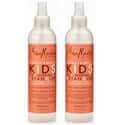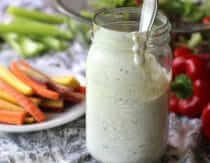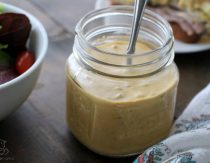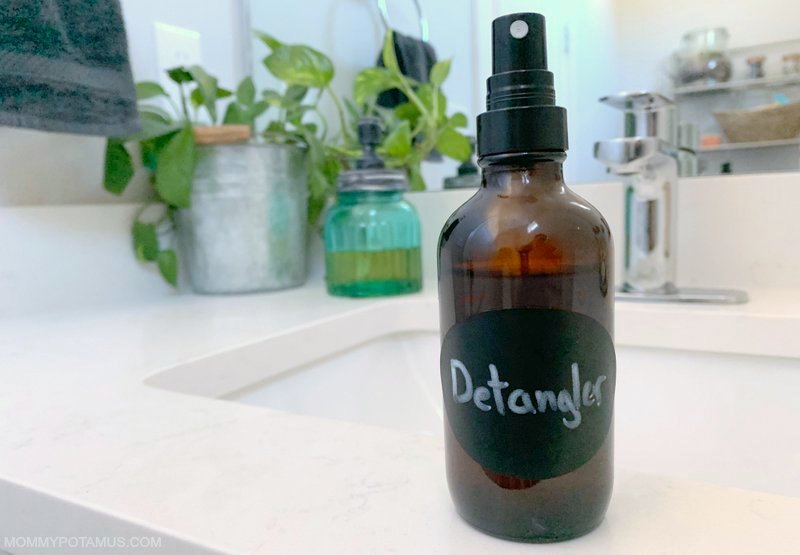
Inside: Natural hair care doesn’t have to be complicated! Here are three homemade hair detangler recipes that are inexpensive and simple to make, plus what to buy if you don’t want to DIY.
Has your mother ever threatened offered to shave your head? Mine has.
You guys, this is a woman who didn’t raise her voice when I wrecked her bought-that-very-day car when I was sixteen and made pancakes for my college friends at 2am while we studied. She’s practically a saint, but when I was little, brushing my long hair would nearly bring her to her wits end. One night, she “gently” offered to just shave my head.
Now that I’m a mom, I get it. It’s no fun to watch a child shed tears over tangles. I tried different brushes and combs which definitely helped, but it was still something my daughter dreaded. Then I remembered the detangler spray my mom eventually found – YES!
And nooooooooo.
I mean, have you seen the ingredients in most children’s detanglers?
Fortunately, there’s a natural solution that works, and you may already have the ingredients to make it! Or actually make them, because there are several ways to whip up homemade detangler.
You’ll find three recipes below, along with better store-bought options if you don’t want to DIY.
How Detanglers Work
According to chemist Anne Marie Helmenstine, Ph.D.:
Although there are many possible ingredients in hair detangler, they all work by altering the surface of your hair. Hair detangler is a type of hair conditioner that smooths your hair by coating it with an oil or polymer and/or by acidifying it so that the hair’s surface tightens up, smoothing the scales on the hair’s outer surface or cuticle and imparting a positive electrical charge to prevent the static that can worsen tangles.” (1)
The first two recipes I’m going to share with you are alternatives to the synthetic polymers mentioned by Dr. Helmenstine.
The last recipe works using a weak acid (apple cider vinegar) to smooth the cuticle. Though I wish they were, none of these formulas are miracles in a bottle. However, they do make the process easier without leaving hair greasy.
Tip: Use A Wet Brush
This brush works wonders on tangles, especially when combined with the detangling recipes below.
Also, when you don’t have time to DIY, Overall, Shea Moisture Kids Hair Care Coconut & Hibiscus KIDS Extra Moisturizing Detangler has a clean ingredient list (overall) that incorporates both marshmallow root and slippery elm extracts. The only ingredient I don’t love is the behentrimonium chloride, which is a conditioning salt that is used as a preservative. Of all the options I’ve looked at, though, it’s the best.
Why use marshmallow root in detangling spray?
As the quote from Dr. Helmenstine I mentioned earlier explains, some detanglers smooth hair by coating them in polymers. Even some DIY detanglers take this approach by using diluted conditioner, which often contains polymers.
I’m not a fan of this approach because – as I explained in my post on gelatin masks for strong, shiny hair this only makes the hair **look** healthy – in reality it’s doing the exact opposite. Silicone blocks moisture from reaching the hair shaft, which can cause strands to become dry and brittle over time. Other polymers such as dimethicone have similar effects.
Fortunately, there’s a better way to coat the hair – mucilage!
Okay yeah, it’s not a pretty word, but it works.
For hair, mucilage provides the much needed slip for manageable detangling. Water enables the transport of mucilage in between the hair fibers where the slimy consistency makes the strands slippery. By getting in between the strands, mucilage temporary weakens strand cohesion. Without strand cohesion the strands glide past each other easily; allowing for easier separation and removal of shed hair. Aside from mucilage, herbs also come with a plethora of water-soluble minerals and vitamins all of which nourish the hair and sooth the scalp while detangling.” (2)
Mucilage also helps coat and protect an irritated throat (see my sore throat tea and sore throat spray recipes), ease heartburn and stomach aches, improve gut health and more, which I love because it means that marshmallow root – the mucilage-rich herb in first recipe below – can also be used for other purposes. If you order some and want to see what else you can make, here are seven uses for marshmallow root and how to prepare it.
Now back to hair . . .
Using Essential Oils In Your Detangler
Though completely optional, essentials are a wonderful addition to the marshmallow root recipe. Not only do they have properties that benefit hair, they smell amazing.
Here are some options that are safe for kids:
- Lemon essential oil smells amazing, and is helpful for balancing oily hair. Depending on how much you use and how often it may lighten your hair – some people use it to create natural-looking highlights. (where to buy lemon essential oil)
- Patchouli and tea tree also have astringent properties which are beneficial for oily hair. Rosemary is also a good option, but it is not recommended for kids under six. Click here to read more about using essential oils with children. (where to buy patchouli, where to buy tea tree essential oil, where to buy rosemary essential oil)
- Chamomile and lavender essential oil are helpful for dry hair (where to buy chamomile, where to buy lavender)
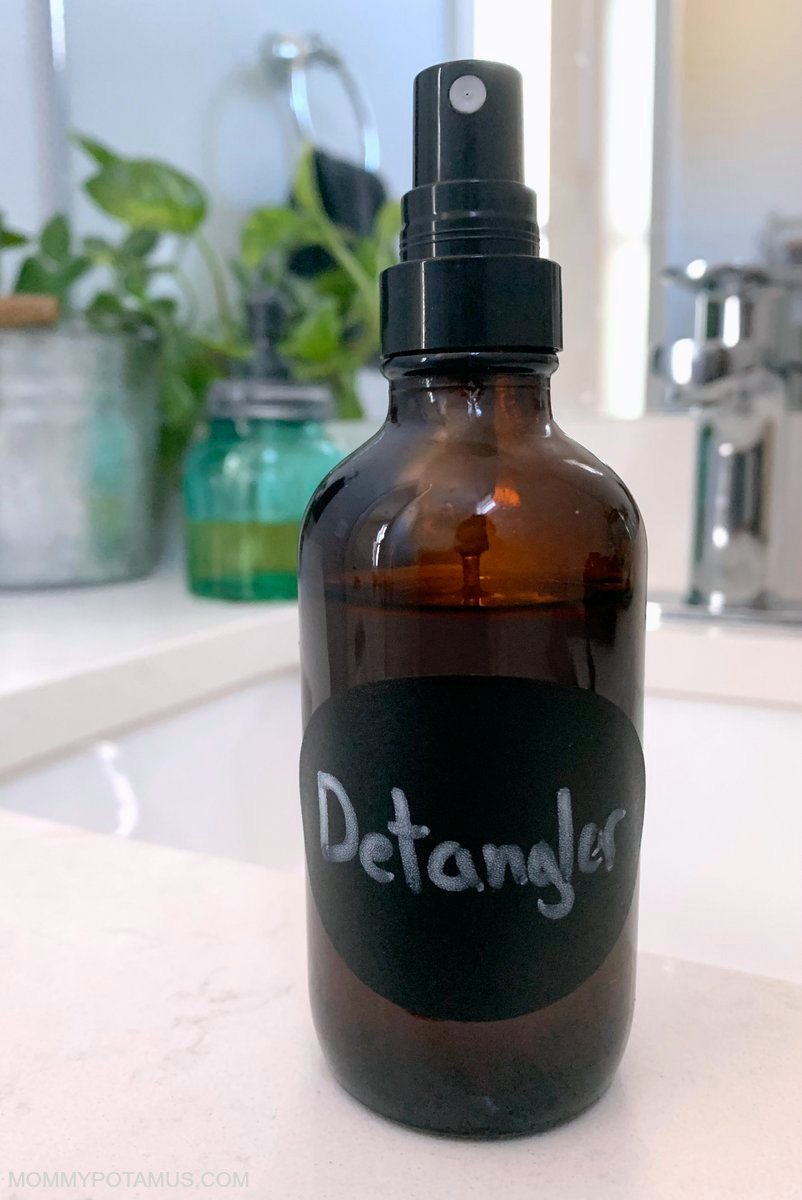
Recipe #1: Marshmallow Root Detangling Spray Recipe
This stuff works amazingly well, but it doesn’t smell awesome. For that reason, I definitely recommend using essential oils with this formula. You’ll find some suggestions above.
Ingredients
- 1 1/2 cups water
- 3 tablespoons marshmallow root, you’ll need less than half an ounce for this recipe)
- 3 tablespoons apple cider vinegar (where to buy apple cider vinegar)
- 1 1/2 teaspoons jojoba oil or olive oil (where to buy jojoba oil, where to buy olive oil)
- Up to 30 drops essential oil (optional, see suggestions below)
To Make
Add marshmallow root and water to a small pot and bring to boil, then reduce heat and allow to simmer for 15-20 minutes. Remove from heat and allow to cool for another 15-20 minutes, then strain using cheesecloth. Add essential oils and oil to the vinegar and allow to sit for a few minutes, then stir vigorously. Add the marshmallow root to the vinegar mixture and pour into a spray bottle.
To Use
Shake well before using. Spritz onto dry or wet hair, then comb through. I think the thicker gel works better, so I just spray in the stream setting and then smooth over the hair. Allow the detangler to soak into the hair for 1-2 minutes, then comb through.
Shelf Life
Store in the refrigerator. Because it doesn’t not contain any preservatives, I make small batches and use within about a month.
Recipe #2: Homemade Flax Seed Hair Detangler
This recipe is great because it uses ingredients that are easily accessible. I don’t think it works quite as well as the marshmallow root recipe above, but if you need something quick it’s a great option.
Ingredients
- 1 tablespoon flax seed
- 1 1/2 cups water
- 1 1/2 teaspoons jojoba or olive oil (where to buy jojoba oil, where to buy olive oil)
- 3 tablespoons apple cider vinegar (where to buy apple cider vinegar)
- Up to 30 drops essential oil (optional – see suggestions listed above under the marshmallow root recipe)
To Make
Add seeds and water to a small pot and bring to boil, then reduce to medium heat and allow the seeds to continue cooking for 15-20 minutes, stirring often. Remove from heat and strain seeds through a fine mesh sieve or a pair of pantyhose, then stir in oil. If you are adding essential oils, add them to the apple cider vinegar and allow them to sit for a few minutes, then stir vigorously. Pour apple cider vinegar into the flax gel/oil mixture.Allow the mixture to set in the fridge so you can tell what the final consistency is. If it’s too gel-like to be used in a spray bottle, dilute as needed. Place liquid in a spray bottle.
To Use
Spritz onto dry or wet hair, then comb through. If the mixture is too thick it will spray as a stream rather than a mist. I think the thicker gel works better, so I just spray in the stream setting and then smooth over the hair. Allow the detangler to soak into the hair for 1-2 minutes, then comb through.
Shelf Life
Store in the refrigerator. Because it doesn’t not contain any preservatives, I make small batches and use within 3-4 weeks.
Recipe #3: Homemade Apple Cider Vinegar Hair Detangler
Ingredients
- 1/3 cup apple cider vinegar (where to buy apple cider vinegar)
- 1/3 cup distilled water (or water that has been boiled and cooled)
- 1 teaspoon jojoba or olive oil (where to buy jojoba oil, where to buy olive oil)
- Up to 30 drops essential oil (optional – see suggestions listed above under the marshmallow root recipe)
Using Essential Oils In Your Detangler
Though completely optional, essentials are a wonderful addition to the apple cider vinegar recipe. Not only do they have properties that benefit hair, they smell amazing. (And for those who don’t love the smell of vinegar, that can be a huge plus.)
Here are some options that are safe for kids over two:
- Lemon essential oils smells amazing, and is helpful for balancing oily hair. Depending on how much you use and how often it may lighten your hair – some people use it to create natural-looking highlights. (where to buy lemon essential oil)
- Patchouli and tea tree also have astringent properties which are beneficial for oily hair (where to buy patchouli, where to buy tea tree essential oil)
- Chamomile and lavender are helpful for dry hair (where to buy chamomile, where to buy lavender)
To Make
If you’re using essential oils, add them to the apple cider vinegar allow it to sit for a few minutes. Add the oil and stir vigorously, then add the water. I use 1/3 cup because we have hard water. Hard water is alkaline and therefore counteracts the acidity of the apple cider vinegar (ACV) – for that reason I keep the concentration of ACV pretty high in my solution. You may find that a more diluted version works well for you – add water as needed.
To Use
This recipe works best as a leave-in conditioner applied after shampoo. Shake well before using then spritz thoroughly onto hair. Allow the mixture to sit for a few minutes, then comb through using a wide-tooth comb.
Shelf Life
I have never had a batch go bad, but because it doesn’t contain any preservatives I store mine in the fridge and use within four to six weeks.
Do you have a detangling tip? Please share it below!
FREE Ebook: DIY Body Care Gifts Made Simple
Do you want to give gorgeous, handcrafted gifts for family and friends, without spending a bunch of time on them?
Then I’d love to give you a free copy of DIY Body Care Gifts Made Simple – my step-by-step guide to making gorgeous handcrafted gifts without stressing yourself out – as a gift for signing up for my newsletter. I’ll show you how to make vintage labels, luxurious lotion bars, lip balms, sugar scrubs, body sprays and more like a pro. Sign up for my newsletter and you’ll be redirected to the download page immediately!
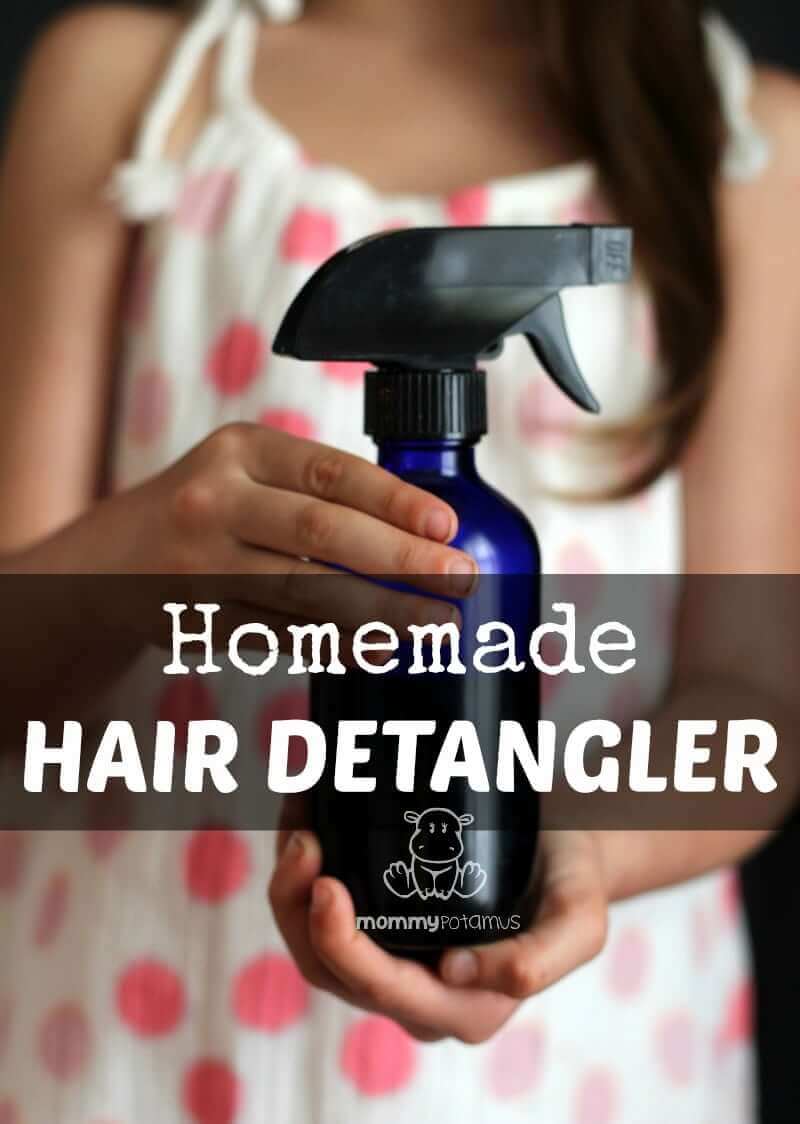
Sources for this article:
Helmenstine, Anne Marie. (2017, March) How To Make Homemade Hair Detangler. Retrieved from https://www.thoughtco.com/how-to-make-homemade-hair-detangler-607707
Tribe of Chic. 5 High Mucilage Herbs For Hair. Retrieved from http://web.archive.org/web/20150219025442/http://mynaturalhairgrowth.net/detanglingherbs/#

